The Foundations of TCM Philosophy
The Interactions of the Five Elements
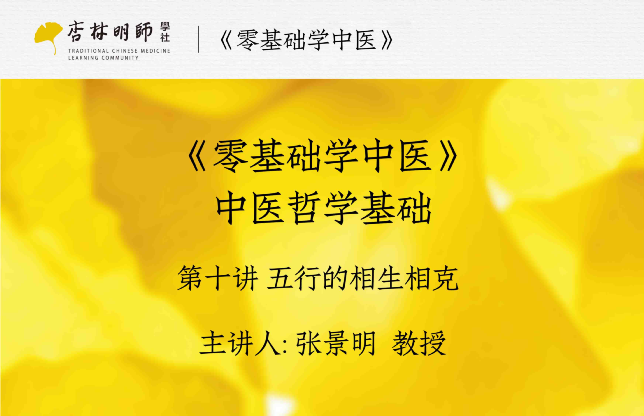

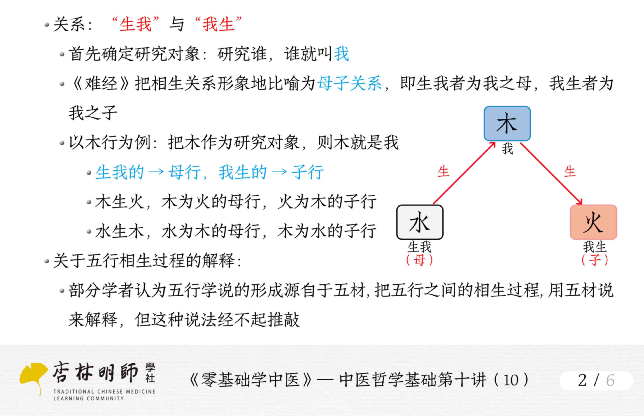
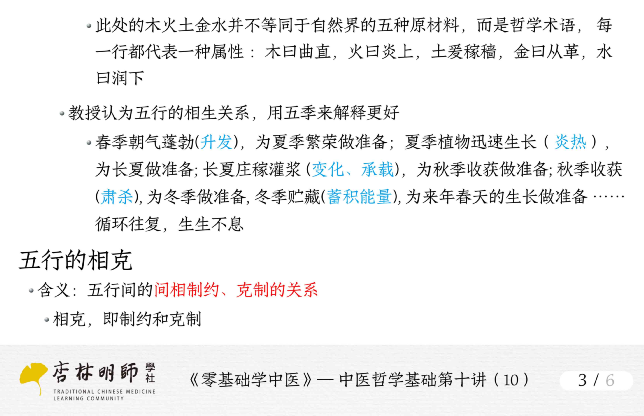
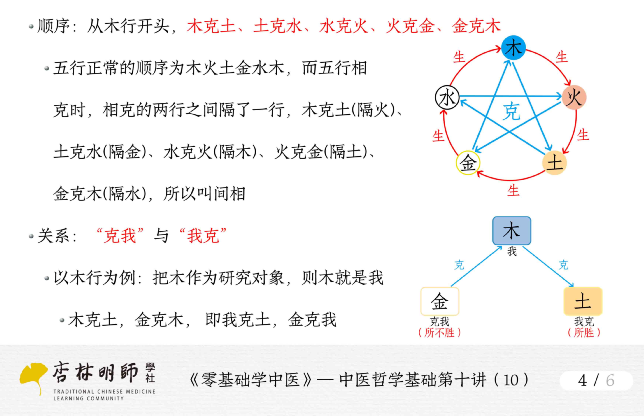
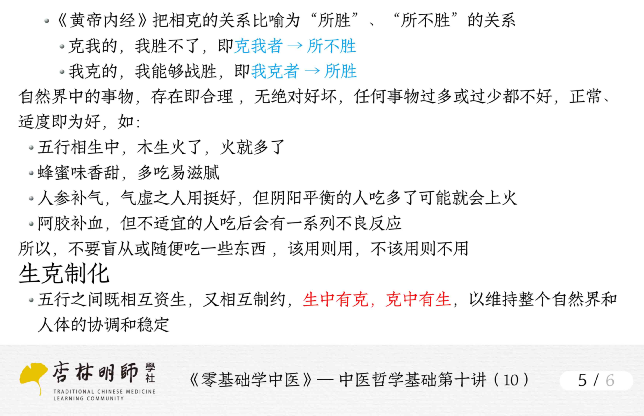
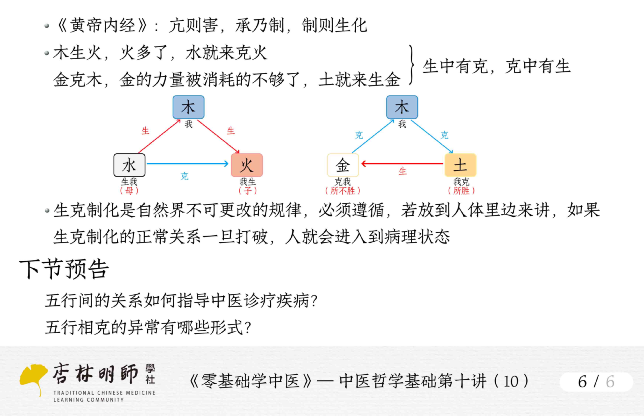
Question:What is the generation cycle of the Five Elements? What is the order?
Answer:The generation cycle of the Five Elements refers to the orderly relationships of nurturing, supporting, and promoting among the five categories: Wood, Fire, Earth, Metal, and Water.
Order: Starting from Wood, Wood generates Fire, Fire generates Earth, Earth generates Metal, Metal generates Water, and Water generates Wood. The Five Elements are abstracted from the observation of the five seasons in nature, with Spring corresponding to Wood, thus the generation cycle begins with Wood. The reciprocal nurturing among the Five Elements forms a continuous process of life in nature.
Question:What is the overcoming cycle of the Five Elements? What is the order?
Answer:The overcoming cycle refers to the orderly relationships of restraint and control among Wood, Fire, Earth, Metal, and Water.
Order: Starting from Wood, Wood overcomes Earth, Earth overcomes Water, Water overcomes Fire, Fire overcomes Metal, and Metal overcomes Wood. In the overcoming cycle, there is an element that is separated by one element, for example, Wood overcomes Earth (separated by Fire), Earth overcomes Water (separated by Metal), Water overcomes Fire (separated by Wood), Fire overcomes Metal (separated by Earth), and Metal overcomes Wood (separated by Water), hence it is termed as ‘inter-overcoming’. The overcoming cycle is an abstract summary of the natural laws of climate and victory, thus it also begins with Wood.
Question:What does the concept of generation and overcoming in the Five Elements mean?
Answer:The Five Elements have both promoting and restraining effects, with generation containing overcoming and overcoming containing generation, maintaining a dynamic balance of the whole and serving as the driving force for the development and change of things.
The generation and overcoming of the Five Elements are inseparable aspects; without generation, there would be no occurrence and growth of things; without overcoming, the development of things would become overly exuberant and unbalanced. Only with generation containing overcoming and overcoming containing generation, can the coordination and balance between things be maintained, promoting stable and orderly development and change.
Question:What does “Excess leads to harm, acceptance leads to control, control leads to transformation” mean?
Answer:This phrase originates from the “Suwen: Discussion on the Six Subtle Principles” and is also the origin of the generation, overcoming, and transformation of the Five Elements.
“Excess” refers to a pathological and abnormal state of excessive strength. When “excess” occurs, there must be a corresponding “deficiency”. For example, the common condition of “Liver Yang Rising” is due to “Yin not subduing Yang”, with Liver Yin deficiency as the root cause. Although it is primarily characterized by “excess”, the fundamental reason is still “deficiency”. The phrase “Excess leads to harm” indicates the negative impact on the Five Elements and the body caused by the invasion of excessive pathogenic factors after the body’s righteous Qi is deficient.
Due to the nature of ancient Chinese language, “Acceptance leads to control” and “Excess leads to harm” are intertextual. “Acceptance” actually means “following and connecting”. The generative and overcoming relationships of the Five Elements are mutually supportive and form a closed-loop relationship, while the normal state of “acceptance” is a relationship of mutual restraint and mutual nurturing. “Control” is the normal mechanism of change. Therefore, only when this state of “acceptance” is normal can “control” occur.
Control leads to transformation, which is easier to understand; it means that the normal generative and overcoming relationships of the Five Elements, the transformations of the Five Elements, Yin and Yang, and the Qi and Blood of the organs can be realized under certain conditions, allowing the human body to be harmonious and stable.
Question:Is the relationship of generation among the Five Elements summarized from phenomena such as wood catching fire, fire burning wood to ashes, metals being smelted from ores, metals reaching melting points to become liquid, and seedlings thriving with rain?
Answer:No, the generation of the Five Elements is an abstract summary of the laws of climate and phenology throughout the year. The changes in the seasons are continuous; among the five seasons, Spring belongs to Wood, which is the season of growth and development, preparing for Summer; Summer belongs to Fire, characterized by heat and upward movement, preparing for Late Summer; Late Summer belongs to Earth, where plants approach maturity, possessing the attributes of change and bearing, preparing for the harvest in Autumn; Autumn belongs to Metal, where after the harvest, plants gradually wither, representing the qualities of desolation and purity; Winter belongs to Water, characterized by storage and downward movement, storing the fruits of Autumn and accumulating energy for the next Spring’s budding and growth. This cycle continues endlessly, reflecting the process of generation among the Five Elements through observations of nature’s five seasons.
Question:How is the generative relationship of the Five Elements personified?
Answer:In the generative relationship of the Five Elements, each element has both “nurturing me” and “I nurture” aspects. The “Nanjing” refers to this relationship as a “mother-child” relationship, where the one that nurtures is the “mother” and the one that is nurtured is the “child”. For example, taking Wood as an example, if we study who nurtures whom, then Wood is the nurturing element. Water nurtures Wood, thus Water is the mother of Wood. Wood generates Fire, thus Fire is the child of Wood.
It is essential to determine the object of study to clarify the mother-child relationship among the Five Elements; if the object is unclear, the relationships among the Five Elements will become confused.
Question:How is the overcoming relationship of the Five Elements metaphorically described?
Answer:In the overcoming relationship of the Five Elements, each element has both “overcoming me” and “I overcome” aspects. The “Neijing” metaphorically describes this as the relationship of “victor” and “vanquished”, where the one that overcomes is the “vanquished” and the one that is overcome is the “victor”.
For example, taking Wood as an example, if we study who overcomes whom, then Wood is the subject. Metal overcomes Wood, thus Metal is the vanquished of Wood. Wood overcomes Earth, thus Earth is the victor of Wood.
Question:What is the purpose of the generation and overcoming of the Five Elements?
Answer:The relationships of generation and overcoming among the Five Elements exist to maintain the dynamic balance of things and to promote their development and change. Without generation, there would be no occurrence and growth of things; without overcoming, the development of things would become overly exuberant and unbalanced. Only with generation containing overcoming and overcoming containing generation can the coordination and balance between things be maintained, promoting stable and orderly development and change.
The theories of Yin-Yang and the Five Elements can be simply described as a philosophy of achieving harmony (fully reaching the state of balance and harmony); excess leads to harm, acceptance leads to control, and only under the influence of this generation containing overcoming and overcoming containing generation can the natural world and the human body maintain a dynamic balance.
Question:Each element in the Five Elements has its own nurturing, nurturing me, overcoming me, and I overcome relationships. When one organ becomes ill, does it simultaneously affect the other four organs?
Answer:Under normal circumstances, there exists a physiological relationship of generation, overcoming, and transformation among the five organs. Once one organ becomes ill, this balance is disrupted, leading to abnormal generation and overcoming, known as pathological transmission among mother and child.
According to the theory of the Five Elements, each element has its own nurturing, nurturing me, overcoming me, and I overcome relationships. Theoretically, one organ’s illness can affect the other four organs through different pathways. However, in clinical practice, one should not rigidly adhere to theory; rather, one should analyze based on the specific conditions of the patient and the manifestations of their illness to accurately diagnose and effectively treat.
For example, Liver Qi stagnation often affects the Spleen, and Liver Qi stagnation can transform into Fire, affecting the Heart and Lungs. Liver Qi issues rarely affect the Kidneys. However, if there is Liver Blood deficiency, it most commonly affects the Kidneys (Liver and Kidney deficiency), and rarely affects the Lungs. The general rule is that the closest organs are most affected, similar to how in life, those who can be harmed are often the closest people.
Question:How to understand the relationships of generation, overcoming, and mutual insult among the five organs?
Answer:Generation among the Five Elements refers to the orderly relationships of nurturing, supporting, and promoting among Wood, Fire, Earth, Metal, and Water. The order of generation is: Wood generates Fire, Fire generates Earth, Earth generates Metal, Metal generates Water, and Water generates Wood.
In the generative relationship of the Five Elements, each element has both “nurturing me” and “I nurture” aspects. The “Nanjing” refers to this relationship as a mother-child relationship: the one that nurtures is the mother, and the one that is nurtured is the child.
Thus, the generation of the Five Elements is essentially the nurturing, promoting, and supporting of one element towards its child element. Taking Fire as an example, Wood generates Fire, thus the nurturing element is Wood, and Wood is the mother of Fire; Fire generates Earth, thus the child element is Earth, and Earth is the child of Fire. Wood and Fire have a mother-child relationship, and Fire and Earth also have a mother-child relationship.
Overcoming among the Five Elements refers to the orderly relationships of restraint, control, and suppression among Wood, Fire, Earth, Metal, and Water. The order of overcoming is: Wood overcomes Earth, Earth overcomes Water, Water overcomes Fire, Fire overcomes Metal, and Metal overcomes Wood.
In the overcoming relationship of the Five Elements, each element has both “overcoming me” and “I overcome” aspects. The “Neijing” refers to the overcoming relationship as the “victor” and “vanquished” relationship: the one that overcomes is the “vanquished”, and the one that is overcome is the “victor”.
Thus, the overcoming of the Five Elements is essentially the restraint and control of one element over its vanquished element. Taking Wood as an example, since Wood overcomes Earth, the element that is overcome is Earth, which is the vanquished of Wood; since Metal overcomes Wood, the element that overcomes is Metal, which is the vanquished of Wood.
Mutual insult refers to the reverse restraint and control of the vanquished element over the victor element.
The order of mutual insult among the Five Elements is the opposite of overcoming: Wood insults Metal, Metal insults Fire, Fire insults Water, Water insults Earth, and Earth insults Wood. The causes of mutual insult can be due to both “excess” and “deficiency”.
Excess-induced mutual insult: When the victorious element in the Five Elements is overly strong, the element that originally restrained it not only fails to restrain it but is instead subjected to reverse restraint. For example, if Wood energy is excessively exuberant, the Metal that should overcome Wood not only fails to restrain it but is instead bullied by Wood, resulting in the phenomenon of “Wood excessively insulting Metal”.
Deficiency-induced mutual insult: When the vanquished element in the Five Elements is overly weak, it not only fails to restrain its victorious element but is instead subjected to reverse restraint. For example, when Wood energy is excessively weak, the Earth that should overcome Wood will be restrained by the weakness of Wood, resulting in the phenomenon of “Wood deficiency insulting Earth”.
For instance, the Lung Metal should restrain the Liver Wood, but due to excessive anger leading to excessive Liver Fire, the Lung Metal, which is weak, cannot restrain the Liver Wood and instead suffers from the reverse restraint of Liver Fire, resulting in symptoms such as irritability, flushed face, and even coughing or hemoptysis, which is termed “Wood Fire punishing Metal”. Similarly, if the Spleen Earth is weak and cannot restrain the Kidney Water, this deficiency leads to mutual insult, resulting in generalized edema, termed “Earth deficiency insulting Water”.
Question:Will liver issues affect the Spleen and Lungs? Is it the deficiency or excess condition that affects them?
Answer:The Liver belongs to Wood, and the Lungs belong to Metal; in the Five Elements, Metal overcomes Wood. If Liver Wood stagnates and transforms into Fire (Liver Fire), and if the Liver Fire is too intense while the Lung Metal is somewhat weak, then the Liver Fire may not heed the management and instead bully the Lung Metal, which is a case of reverse insult. This is an excess condition.
Liver diseases and Heart diseases are both excess conditions; excessive Heart Fire can drain both Heart Fire and Liver Fire.

